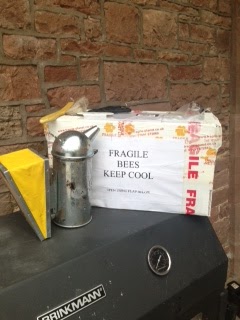 |
| GOING, going, going - gone! |
He-who-should-be-obeyed-but-rarely-is told me not to get carried away, not to stick my hand up and not to bid for anything ... not the sort advice I really wanted to hear as I took my seat in the arena of Hope's Auction in Wigton, Cumbria the other day.
It was a poultry and waterfowl event and I wanted to go along just for the experience although I thought maybe a couple of turkeys or some goslings would not go amiss.
But it's very hard to get into the spirit of things when your nearest and dearest gives a list of not-what-to-do before you've even sat down. Anyway, I resisted the urge to bid as some rabbits, guinea pigs and hamsters were wheeled out and offered at the beginning ... quite what they had to do with birds is anyone's guess.
Then dozens of fertilised eggs were auctioned off and it occurred to me that I could probably sell my Scots Dumpys' produce for one pound an egg instead of frying and serving them up to my hubby every morning. With three healthy cockerels roaming around the hen pen there's never been a question over the fertility of the eggs, so that's an idea stored away for another time.
 |
| AND THE NEXT LOT ... Hope's Auction in Cumbria |
Meanwhile, back to the auction ... with the exception of a few ducks there were some motley offerings that looked as though they'd come straight from a refuge so the temptation to bid was not that powerful.
And then the strangest thing happened - some Indian Fantails were exhibited; tumblers we used to call them when I was a kid and anything that takes me back to my childhood makes me go all misty eyed and nostalgic. Before I knew it I was bidding for them but the auctioneer wasn't taking a blind bit of notice.
I thought a knowing nod, a wink or a tap on the nose were internationally recognised signs but not in this auction and so I missed out. But wait! A second set came out and this time I started gesturing quite wildly to attract the auctioneer's attention; with arms flailing around like windmill in a gale everyone else seemed to notice but he didn't seem to acknowledge me. By this time hubby was laughing along with a few others in our immediate vicinity and gave me an oval disc with the number 26 on it. He whispered: 'Trying using that - they'll only take bids from people who've registered.' By this time there were a few more sniggers in the crowd and I realised I was in danger of becoming the entertainment. However, that feeling of mild irritation that I'd been set up soon passed with the arrival of the next lot ... would you believe it, another set of fantails! I waved my number energetically. The auctioneer saw me and, even more importantly, acknowledged me by increasing the bid to £24 but some other punter waved his number, and another and another. Ignoring hubby's advice for restraint I continued bidding in an even more determined manner and £80 later I was a proud owner of fantails.
 |
| MALE OR FEMALE? |
When we got them home he asked what sex they were and I produced more waffle before heading to the internet to find out how you tell the sex of an Indian Fantail.
 |
| LATEST ADDITIONS: Indian Fantails |
So far I've tried holding the birds upside down on my palm - a cock bird will struggle to upright itself while a hen will just lie there passively, according to one blog. Some wag suggested swinging a copper wire over the birds' heads and if they're female the wire will swing in circles whereas with a male it will simply go back and forth.
I even held a mirror up to each of the four as one 'expert' insisted a male bird will crow and puff out its chest thinking it has a rival while a female will look into the mirror and then look the other way totally disinterested. None of the above worked and seeing how exasperated I was becoming hubby volunteered that he knew a sure fire, 100pc way of telling the male and female birds apart.
'I can guarantee,' he said, 'that the one that lays an egg will be female!'






























